This is only the third time I’ve been able to photograph this behavior. I’ve posted about it previously but it happens seldom enough that I’m always interested in seeing it and I thought some of my readers might be too (again…).
1/3200, f/5.6, ISO 500, Canon 7D Mark II, Canon EF 500mm f/4L IS II USM + EF 1.4 III Extender, not baited, set up or called in
Pied-billed Grebes have more variety in diving technique than any other bird I’m aware of – about a half-dozen techniques have actually been named by researchers. Most of them are variations on the same head-first theme (similar to that of most other diving birds) but one of them, “gradual diving” is quite unique.
Two days ago at Farmington I watched this grebe as it repeatedly dived for fish and interacted with other grebes (its bill shape looks a little strange because there’s a drop of water hanging down from the bottom of it). As usual its dives were always head-first.
- Note – this was a bright, cloudy day so exposing the bird properly made the surface of the water pretty bright in some of the following images.
1/3200, f/5.6, ISO 500, Canon 7D Mark II, Canon EF 500mm f/4L IS II USM + EF 1.4 III Extender, not baited, set up or called in
When I have my lens on these birds I’m always on the lookout for subtle behavioral cues that suggest it might be about to “gradual dive” and something about the posture of this grebe (I’m not even sure what it was) told me it was about to happen so I began to fire a long, extended burst of images.
1/3200, f/5.6, ISO 500, Canon 7D Mark II, Canon EF 500mm f/4L IS II USM + EF 1.4 III Extender, not baited, set up or called in
No matter which diving technique they use they expel air from between their feathers (by flattening them) and also expel air from their air sacs to make them less buoyant but the next cue I noticed that told me it was beginning a gradual dive was the fact that the front of its body was beginning to sink lower into the water.
1/3200, f/5.6, ISO 500, Canon 7D Mark II, Canon EF 500mm f/4L IS II USM + EF 1.4 III Extender, not baited, set up or called in
Next its entire body began to sink. Notice that the grebe has no forward momentum – instead it’s sinking straight down.
1/1600, f/5.6, ISO 500, Canon 7D Mark II, Canon EF 500mm f/4L IS II USM + EF 1.4 III Extender, not baited, set up or called in
Then as it turned slightly toward me it began to raise its rear end up to provide more weight above the surface to push the body downward.
1/2500, f/5.6, ISO 500, Canon 7D Mark II, Canon EF 500mm f/4L IS II USM + EF 1.4 III Extender, not baited, set up or called in
The top of the head and the tail are always the last to submerge. They have great control over the degree and speed of sinking and occasionally I’ve seen them hold this position with their eyes just out of the water for some time.
I’ve cropped several of these images to include the “water boils” to either side of the bird. These birds have considerable ability to rotate their tibiotarsus which allows them to move their feet above, below or level with their body so they can propulsively steer in any direction – including down. Those water boils are evidence of that ability.
1/3200, f/5.6, ISO 500, Canon 7D Mark II, Canon EF 500mm f/4L IS II USM + EF 1.4 III Extender, not baited, set up or called in
Once its eyes disappear the grebe is committed to completing the dive.
1/3200, f/5.6, ISO 500, Canon 7D Mark II, Canon EF 500mm f/4L IS II USM + EF 1.4 III Extender, not baited, set up or called in
The last thing to completely disappear from view is always the tip of the tail.
1/4000, f/5.6, ISO 500, Canon 7D Mark II, Canon EF 500mm f/4L IS II USM + EF 1.4 III Extender, not baited, set up or called in
And then the grebe was gone.
The speed and duration of this kind of dive varies considerably. I’ve seen them disappear beneath the surface in significantly less than a second but I’ve also seen it take much, much longer than that as they keep their eye above water and watch what’s going on around them.
It’s difficult to estimate how often Pied-billed Grebes use this technique but I’d say I’ve seen several thousand head-first dives for every gradual dive I’ve witnessed. And I’ve never seen any other grebe species do it.
Ron


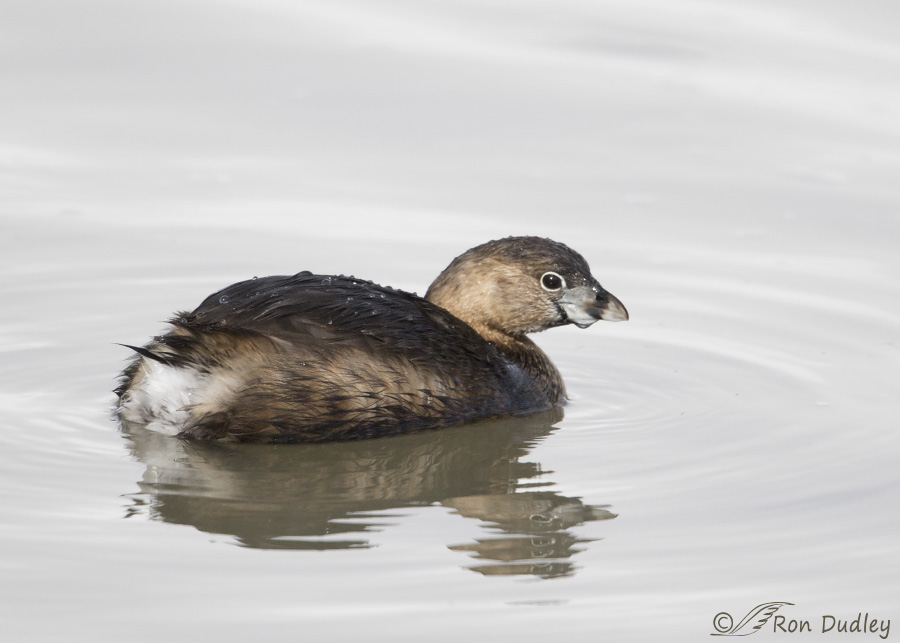
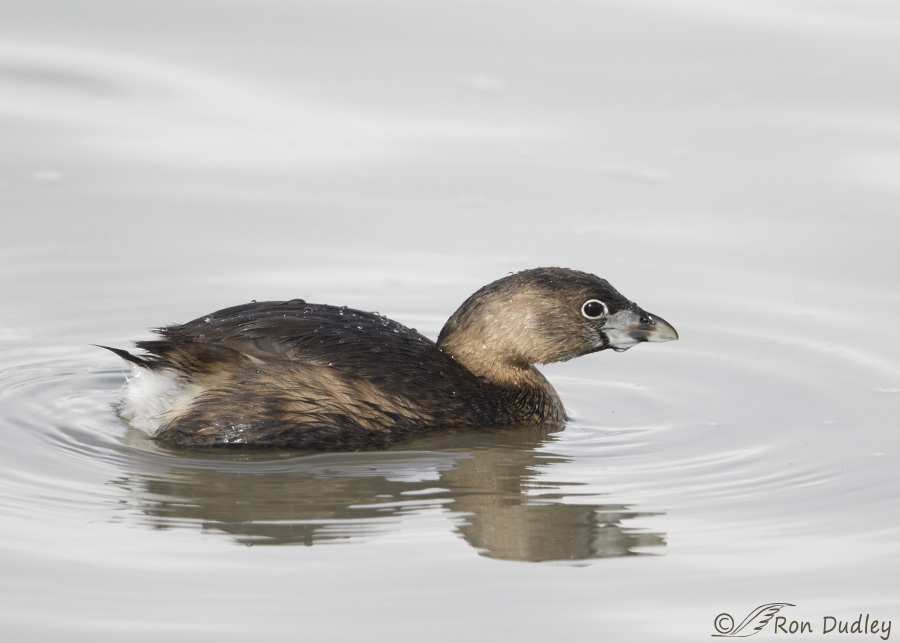
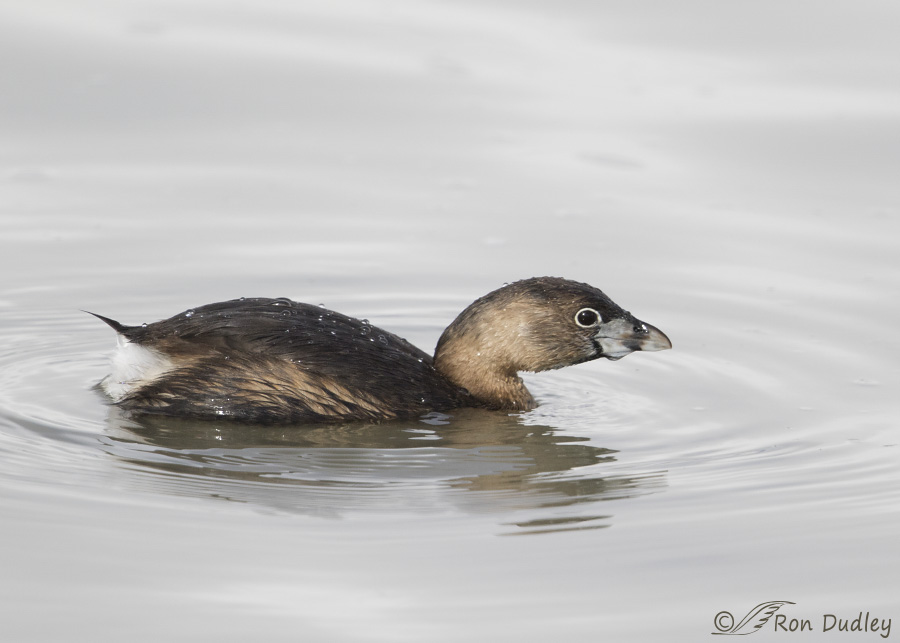
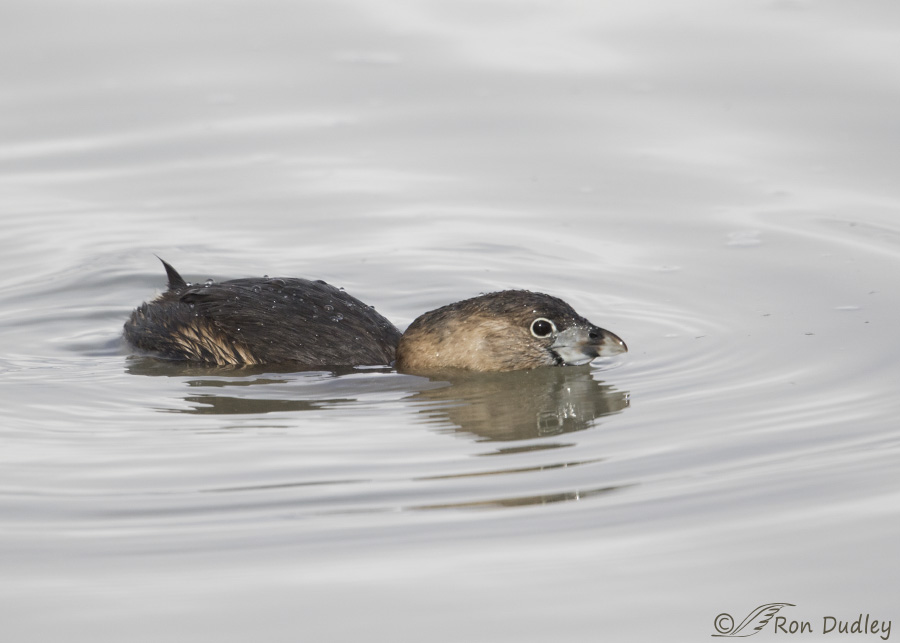
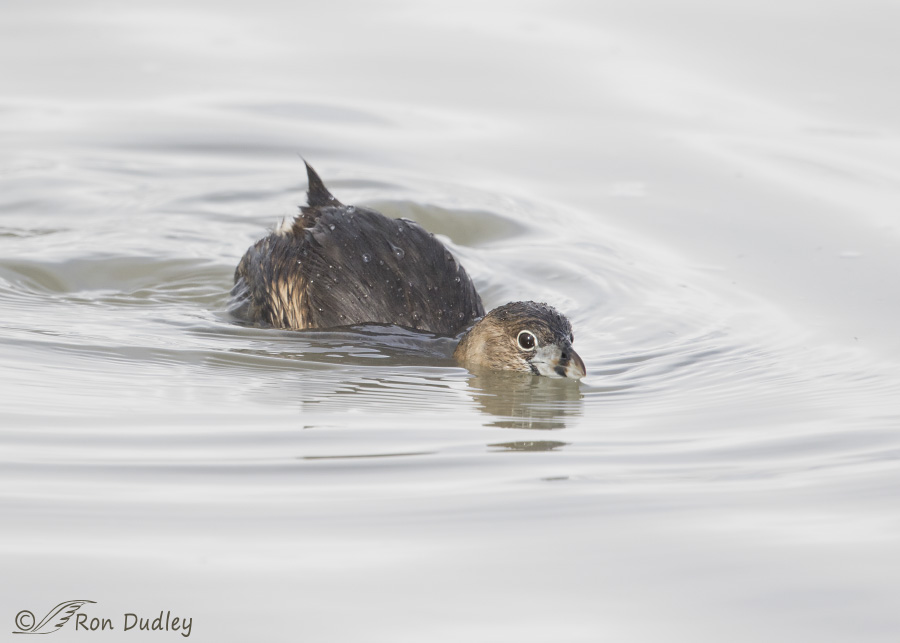
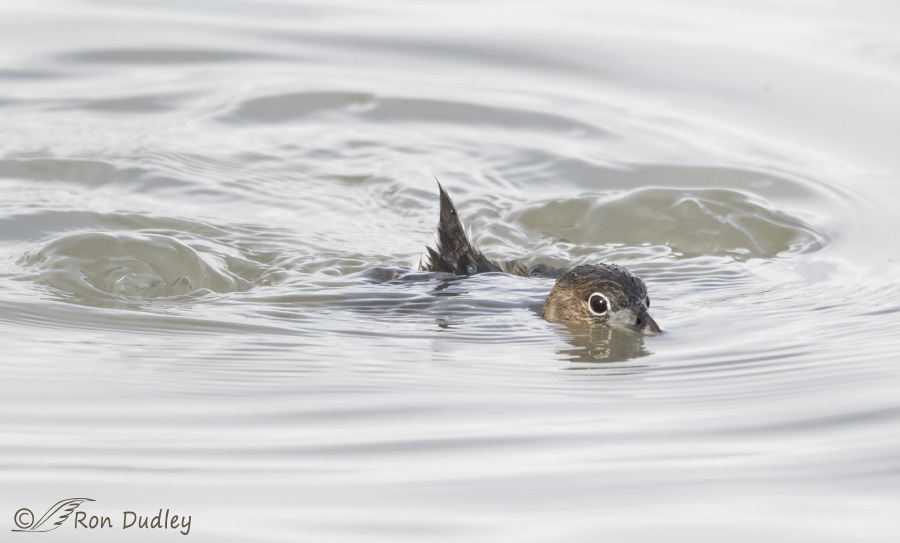
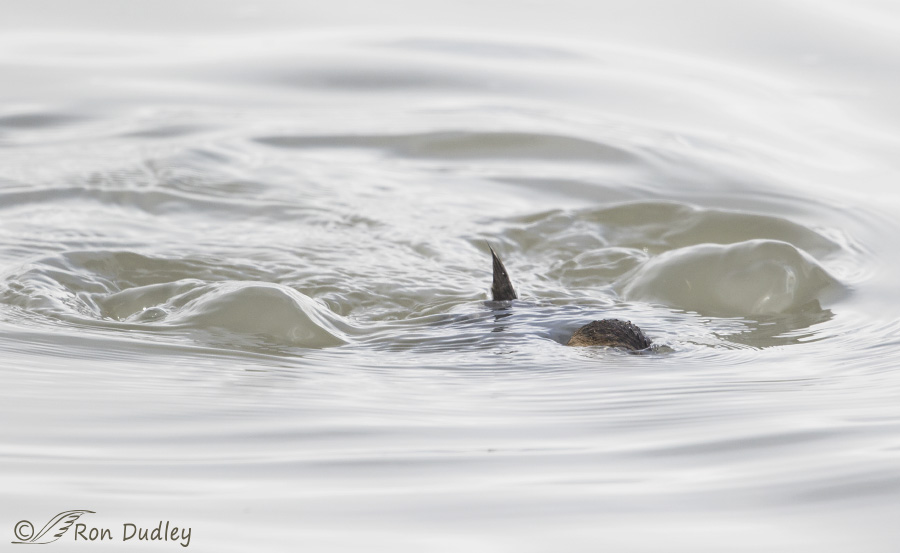
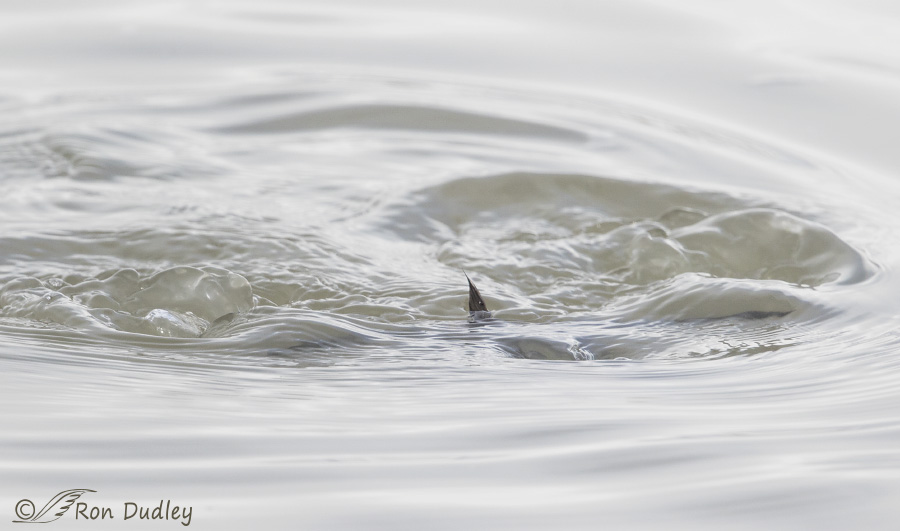
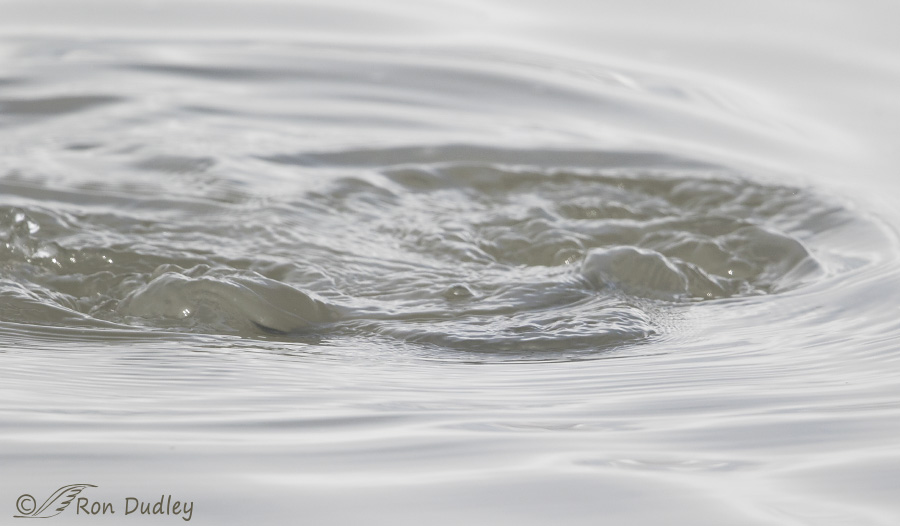
Very interesting behavior Ron. I will look out for this next time I am at the local farm pond. It is funny, before I saw Dick’s comment I thought to myself “Gee, Ron sure has a extensive photographic collection of bird behavior, it would be valuable for researchers around the world”; and then I see Dick’s comment 🙂
Thanks, Ed, As you know I’m nuts about behaviors. In fact I often prefer photographing them over typical “beautiful bird shots”.
How fascinating.
And what a privilege to see – and wonder at.
Thank you, EC.
Hi Ron,
I was interested in your comment that you only see one gradual dive for every thousand other dives. My experience is quite different and I wonder if it has something to do with location. The best place to see Pied-billed Grebe near me is a lake about one mile in circumference in a popular park. There are Grebe here all year, about 10 or so during the summer, growing to double that in the fall with the young. There is a trail all around the lake and there are always walkers, joggers, and bikers on the trail. The Grebe seemed to be used to the people and will sometimes come quite close to shore, usually in an area with lots of brush. If you come up on a Grebe near the shore like this, it will almost always do the gradual sinking. Perhaps incorrectly, I’ve always associated this as an escape mechanism. I have never seen another (Western, Clark’s, Red-breasted, or Horned) Grebe do this.
Interesting that you see the behavior so often, John. When I’m with these birds it’s usually at a pond where there’s no one on foot and I’m typically shooting from my pickup so they don’t see me as a potential threat. That may explain why I see it so seldom.
The way that bird can submerge itself like that reminds me of a submarine…it seems impossible. I wonder what they do to make themselves pop to the surface and become buoyant again…I guess they use their feet to propel them up, but how do they restore buoyancy???
On checking out the comments, I see others see the connection to a sub…but the questions remain…
Patty, I agree, they probably use their webbed feet to get back to the surface and then separate their feathers to allow more air between them and then refill their air sacs.
Fascinating series, Ron, and I agree with Dick Harlow’s suggestion!
Thank you, Diane.
Fascinating series. I can’t fathom being able to control all those factors individually to be able to make a dive. I wonder if the slow dive is a learned behavior or an innate one?
Susan, My bet would be that it’s innate but I don’t know that for fact.
Great series Ron. Had never heard of that behavior.
Thanks, Frank.
Down periscope. Fascinating behavior! I had no idea that birds could do this. Those leg muscles must be incredibly powerful. Absolutely amazing! Thank you, “Teech.” I really enjoy being one of your students. 🙂
Yup, that disappearing tail-tip always reminds me of a periscope since it’s the last part of the bird to submerge.
COOL! Always amazes me the different possible ways animals have to accomplish a given task, 🙂 Great series, Ron.:)
Thank you, Judy.
WOW! I also have never seen this behavior.
Excellent behavioral sequence. Please excuse me Ron for hoping you will ‘will’ your behavioral photographs and notes to Cornell Laboratory of Ornithology or some Ornithological organization of your choice. You have a great deal of knowledge backed up with photographic evidence that would be exceptional to the science of Ornithology.
Agree!!!
Dick, At least with this behavior, Cornell is already well aware of if in this species. In fact I got some of the info used in this post from their website.
But, do they have the photographic evidence?
Please don’t underestimate your photography, the best I have witnessed!
I’ll second that motion — and call the question! 🙂
That’s an amazing series of behavioral shots Ron!
Charlotte
Thanks, Charlotte.
This is a behaviour that I haven’t seen. I will have to watch for it next time I see grebes.
Have you only seen Pied-billed Grebes do this? Thanks for this to us!
Yes, Kathy – this species is the only one I’ve seen do it.
What an amazing series of photos!! Thank you for so for sharing & the explanation.
Thanks, Hila.
Absolutely fascinating! Thanks again for sharing your broad experience and insight.
Thank you, Robert.
Just like a mini submarine.
Yup.